International Relations: Ladyboy Phenomenon in Thailand and Asia
VerifiedAdded on 2023/04/22
|7
|1494
|457
Essay
AI Summary
This essay delves into the multifaceted ladyboy phenomenon in Thailand, examining its cultural context and comparing it to other male transgender identities in Southeast and East Asia. The paper explores the terminology surrounding these identities, differentiating between transgender, transvestite, and transsexual individuals, and specifically analyzing the term 'Kathoey' in the Thai context. It highlights the social acceptance and human rights enjoyed by Kathoeys in Thailand compared to the challenges faced by transgender individuals in other parts of East and Southeast Asia, including legal and social discrimination, limited employment opportunities, and health disparities. The essay references various studies and research to highlight the impact of societal marginalization, and the influence of cultural and religious perspectives on the treatment of transgender individuals. It concludes by acknowledging the growth in international relations and globalization's positive impact on societal norms, suggesting a hopeful future of increased tolerance and understanding for transgender communities.

Student Name
[Course title]
international relations
Institutional Affiliation(S)
[Course title]
international relations
Institutional Affiliation(S)
Paraphrase This Document
Need a fresh take? Get an instant paraphrase of this document with our AI Paraphraser
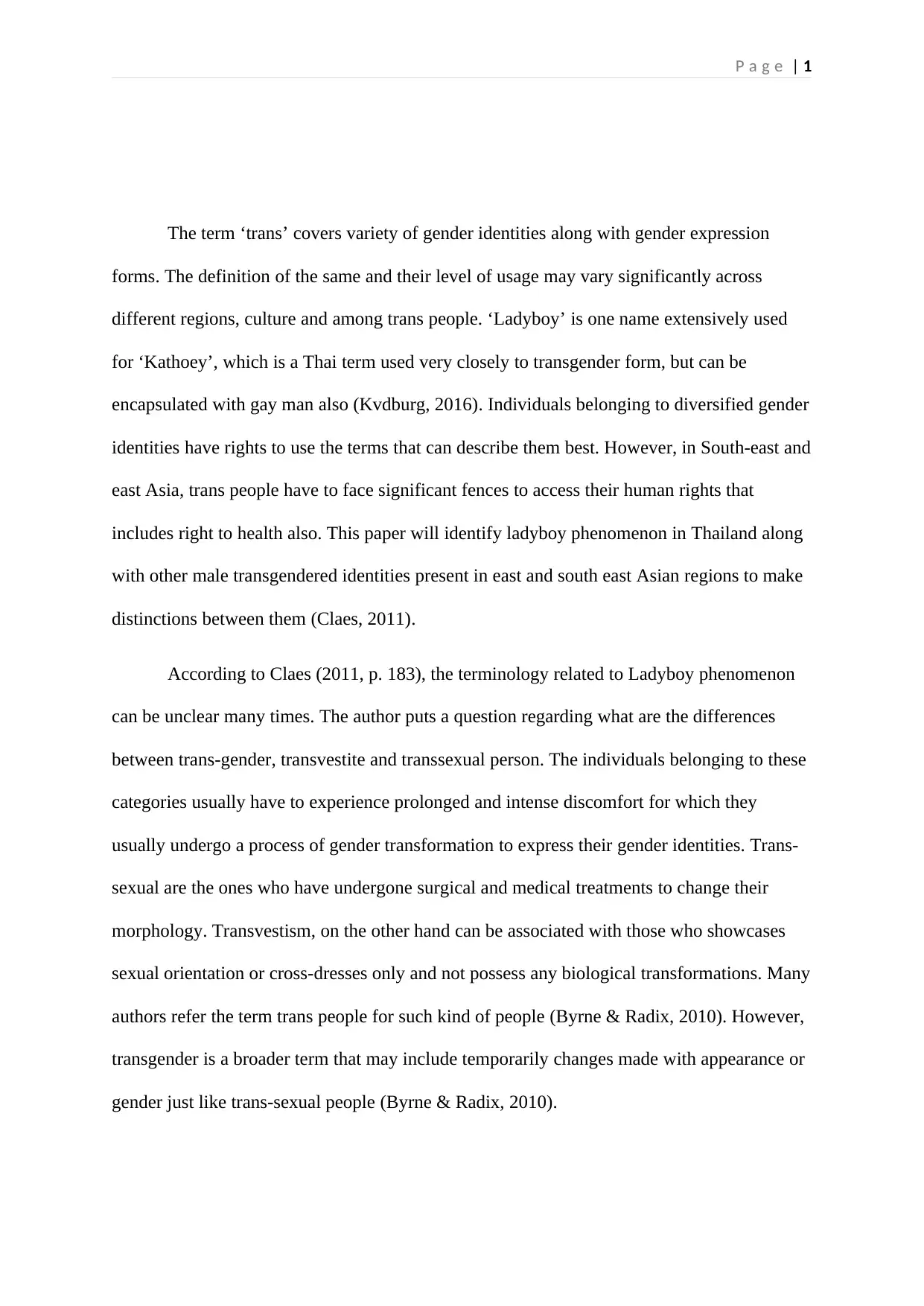
P a g e | 1
The term ‘trans’ covers variety of gender identities along with gender expression
forms. The definition of the same and their level of usage may vary significantly across
different regions, culture and among trans people. ‘Ladyboy’ is one name extensively used
for ‘Kathoey’, which is a Thai term used very closely to transgender form, but can be
encapsulated with gay man also (Kvdburg, 2016). Individuals belonging to diversified gender
identities have rights to use the terms that can describe them best. However, in South-east and
east Asia, trans people have to face significant fences to access their human rights that
includes right to health also. This paper will identify ladyboy phenomenon in Thailand along
with other male transgendered identities present in east and south east Asian regions to make
distinctions between them (Claes, 2011).
According to Claes (2011, p. 183), the terminology related to Ladyboy phenomenon
can be unclear many times. The author puts a question regarding what are the differences
between trans-gender, transvestite and transsexual person. The individuals belonging to these
categories usually have to experience prolonged and intense discomfort for which they
usually undergo a process of gender transformation to express their gender identities. Trans-
sexual are the ones who have undergone surgical and medical treatments to change their
morphology. Transvestism, on the other hand can be associated with those who showcases
sexual orientation or cross-dresses only and not possess any biological transformations. Many
authors refer the term trans people for such kind of people (Byrne & Radix, 2010). However,
transgender is a broader term that may include temporarily changes made with appearance or
gender just like trans-sexual people (Byrne & Radix, 2010).
The term ‘trans’ covers variety of gender identities along with gender expression
forms. The definition of the same and their level of usage may vary significantly across
different regions, culture and among trans people. ‘Ladyboy’ is one name extensively used
for ‘Kathoey’, which is a Thai term used very closely to transgender form, but can be
encapsulated with gay man also (Kvdburg, 2016). Individuals belonging to diversified gender
identities have rights to use the terms that can describe them best. However, in South-east and
east Asia, trans people have to face significant fences to access their human rights that
includes right to health also. This paper will identify ladyboy phenomenon in Thailand along
with other male transgendered identities present in east and south east Asian regions to make
distinctions between them (Claes, 2011).
According to Claes (2011, p. 183), the terminology related to Ladyboy phenomenon
can be unclear many times. The author puts a question regarding what are the differences
between trans-gender, transvestite and transsexual person. The individuals belonging to these
categories usually have to experience prolonged and intense discomfort for which they
usually undergo a process of gender transformation to express their gender identities. Trans-
sexual are the ones who have undergone surgical and medical treatments to change their
morphology. Transvestism, on the other hand can be associated with those who showcases
sexual orientation or cross-dresses only and not possess any biological transformations. Many
authors refer the term trans people for such kind of people (Byrne & Radix, 2010). However,
transgender is a broader term that may include temporarily changes made with appearance or
gender just like trans-sexual people (Byrne & Radix, 2010).
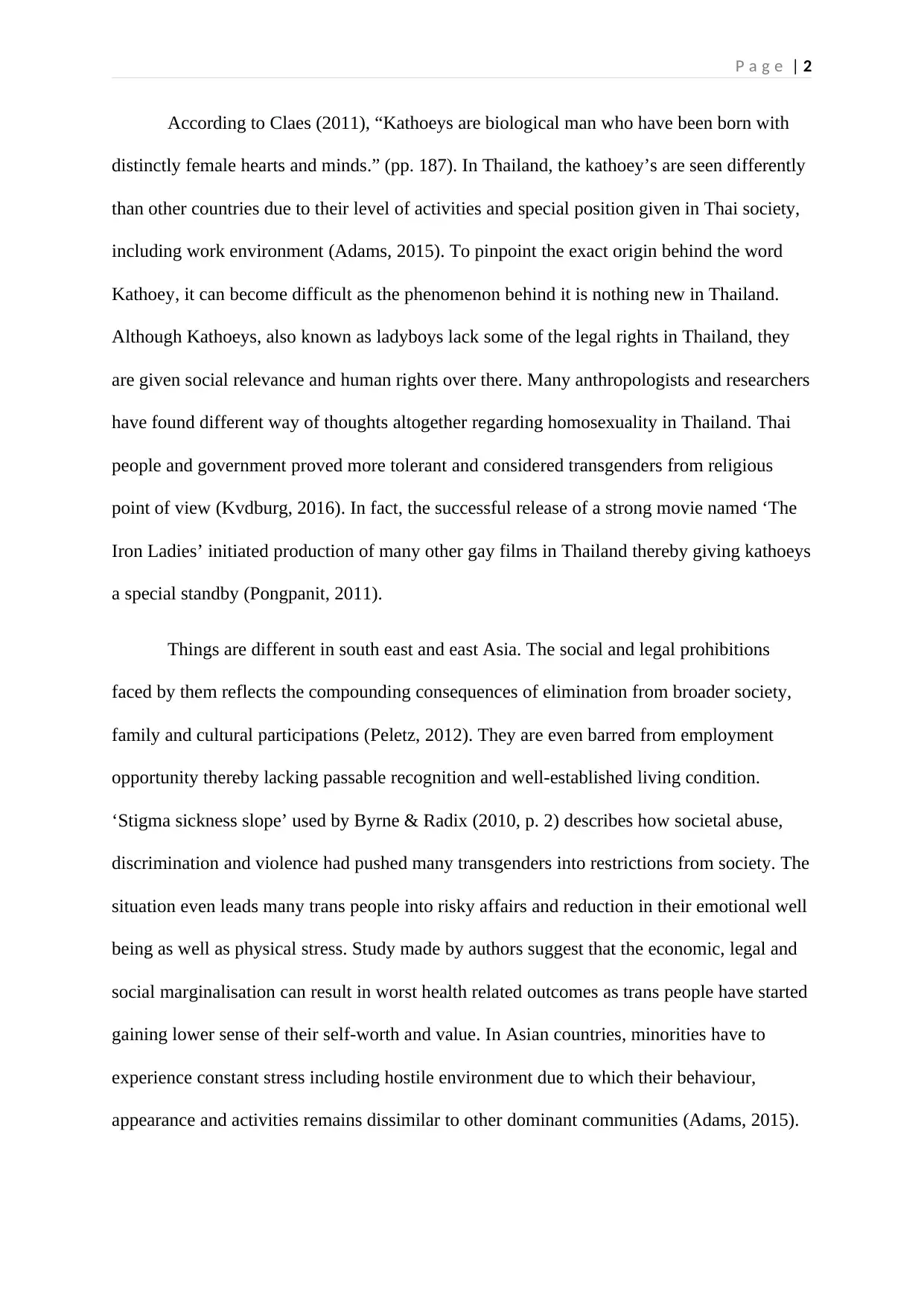
P a g e | 2
According to Claes (2011), “Kathoeys are biological man who have been born with
distinctly female hearts and minds.” (pp. 187). In Thailand, the kathoey’s are seen differently
than other countries due to their level of activities and special position given in Thai society,
including work environment (Adams, 2015). To pinpoint the exact origin behind the word
Kathoey, it can become difficult as the phenomenon behind it is nothing new in Thailand.
Although Kathoeys, also known as ladyboys lack some of the legal rights in Thailand, they
are given social relevance and human rights over there. Many anthropologists and researchers
have found different way of thoughts altogether regarding homosexuality in Thailand. Thai
people and government proved more tolerant and considered transgenders from religious
point of view (Kvdburg, 2016). In fact, the successful release of a strong movie named ‘The
Iron Ladies’ initiated production of many other gay films in Thailand thereby giving kathoeys
a special standby (Pongpanit, 2011).
Things are different in south east and east Asia. The social and legal prohibitions
faced by them reflects the compounding consequences of elimination from broader society,
family and cultural participations (Peletz, 2012). They are even barred from employment
opportunity thereby lacking passable recognition and well-established living condition.
‘Stigma sickness slope’ used by Byrne & Radix (2010, p. 2) describes how societal abuse,
discrimination and violence had pushed many transgenders into restrictions from society. The
situation even leads many trans people into risky affairs and reduction in their emotional well
being as well as physical stress. Study made by authors suggest that the economic, legal and
social marginalisation can result in worst health related outcomes as trans people have started
gaining lower sense of their self-worth and value. In Asian countries, minorities have to
experience constant stress including hostile environment due to which their behaviour,
appearance and activities remains dissimilar to other dominant communities (Adams, 2015).
According to Claes (2011), “Kathoeys are biological man who have been born with
distinctly female hearts and minds.” (pp. 187). In Thailand, the kathoey’s are seen differently
than other countries due to their level of activities and special position given in Thai society,
including work environment (Adams, 2015). To pinpoint the exact origin behind the word
Kathoey, it can become difficult as the phenomenon behind it is nothing new in Thailand.
Although Kathoeys, also known as ladyboys lack some of the legal rights in Thailand, they
are given social relevance and human rights over there. Many anthropologists and researchers
have found different way of thoughts altogether regarding homosexuality in Thailand. Thai
people and government proved more tolerant and considered transgenders from religious
point of view (Kvdburg, 2016). In fact, the successful release of a strong movie named ‘The
Iron Ladies’ initiated production of many other gay films in Thailand thereby giving kathoeys
a special standby (Pongpanit, 2011).
Things are different in south east and east Asia. The social and legal prohibitions
faced by them reflects the compounding consequences of elimination from broader society,
family and cultural participations (Peletz, 2012). They are even barred from employment
opportunity thereby lacking passable recognition and well-established living condition.
‘Stigma sickness slope’ used by Byrne & Radix (2010, p. 2) describes how societal abuse,
discrimination and violence had pushed many transgenders into restrictions from society. The
situation even leads many trans people into risky affairs and reduction in their emotional well
being as well as physical stress. Study made by authors suggest that the economic, legal and
social marginalisation can result in worst health related outcomes as trans people have started
gaining lower sense of their self-worth and value. In Asian countries, minorities have to
experience constant stress including hostile environment due to which their behaviour,
appearance and activities remains dissimilar to other dominant communities (Adams, 2015).
⊘ This is a preview!⊘
Do you want full access?
Subscribe today to unlock all pages.

Trusted by 1+ million students worldwide
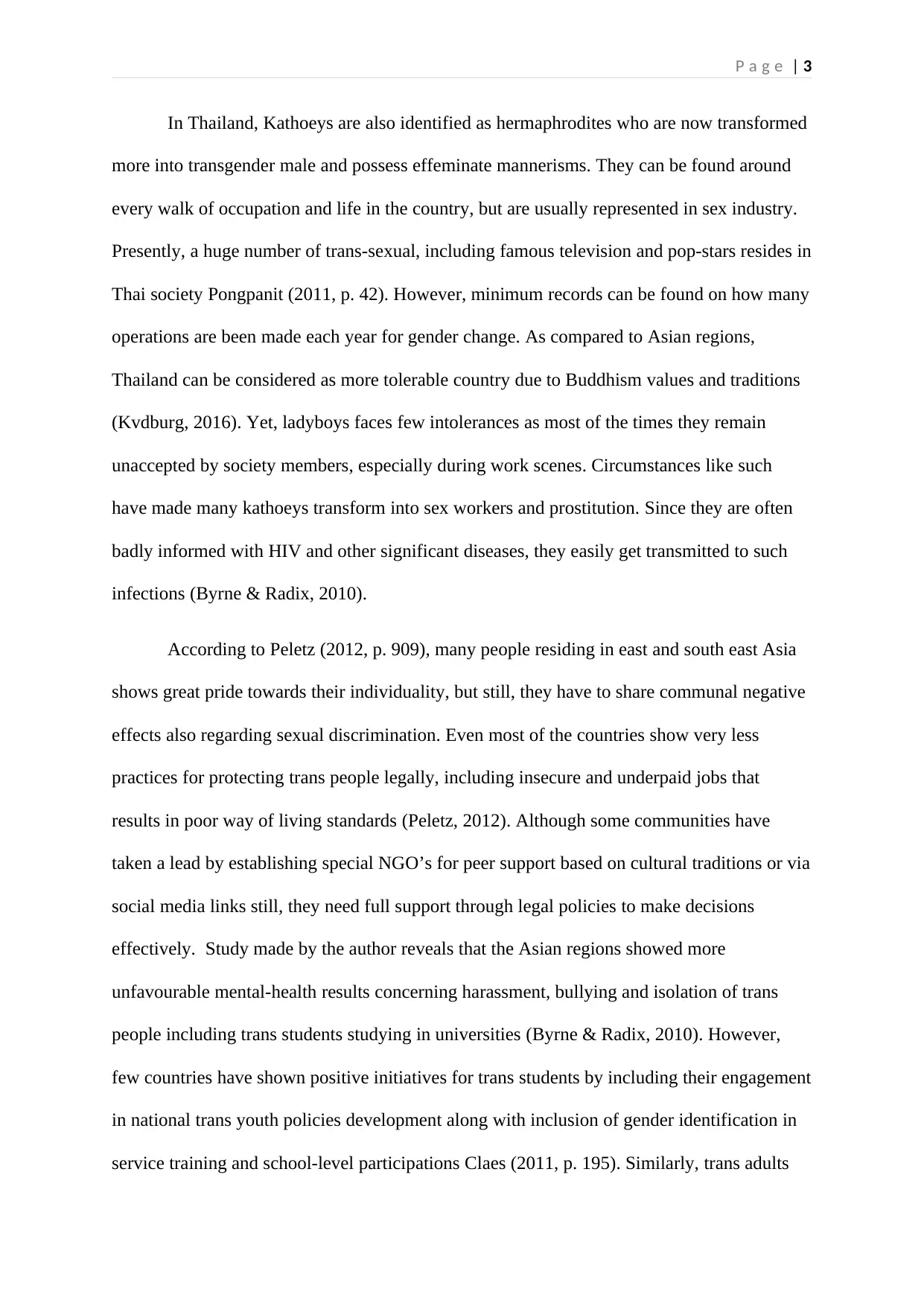
P a g e | 3
In Thailand, Kathoeys are also identified as hermaphrodites who are now transformed
more into transgender male and possess effeminate mannerisms. They can be found around
every walk of occupation and life in the country, but are usually represented in sex industry.
Presently, a huge number of trans-sexual, including famous television and pop-stars resides in
Thai society Pongpanit (2011, p. 42). However, minimum records can be found on how many
operations are been made each year for gender change. As compared to Asian regions,
Thailand can be considered as more tolerable country due to Buddhism values and traditions
(Kvdburg, 2016). Yet, ladyboys faces few intolerances as most of the times they remain
unaccepted by society members, especially during work scenes. Circumstances like such
have made many kathoeys transform into sex workers and prostitution. Since they are often
badly informed with HIV and other significant diseases, they easily get transmitted to such
infections (Byrne & Radix, 2010).
According to Peletz (2012, p. 909), many people residing in east and south east Asia
shows great pride towards their individuality, but still, they have to share communal negative
effects also regarding sexual discrimination. Even most of the countries show very less
practices for protecting trans people legally, including insecure and underpaid jobs that
results in poor way of living standards (Peletz, 2012). Although some communities have
taken a lead by establishing special NGO’s for peer support based on cultural traditions or via
social media links still, they need full support through legal policies to make decisions
effectively. Study made by the author reveals that the Asian regions showed more
unfavourable mental-health results concerning harassment, bullying and isolation of trans
people including trans students studying in universities (Byrne & Radix, 2010). However,
few countries have shown positive initiatives for trans students by including their engagement
in national trans youth policies development along with inclusion of gender identification in
service training and school-level participations Claes (2011, p. 195). Similarly, trans adults
In Thailand, Kathoeys are also identified as hermaphrodites who are now transformed
more into transgender male and possess effeminate mannerisms. They can be found around
every walk of occupation and life in the country, but are usually represented in sex industry.
Presently, a huge number of trans-sexual, including famous television and pop-stars resides in
Thai society Pongpanit (2011, p. 42). However, minimum records can be found on how many
operations are been made each year for gender change. As compared to Asian regions,
Thailand can be considered as more tolerable country due to Buddhism values and traditions
(Kvdburg, 2016). Yet, ladyboys faces few intolerances as most of the times they remain
unaccepted by society members, especially during work scenes. Circumstances like such
have made many kathoeys transform into sex workers and prostitution. Since they are often
badly informed with HIV and other significant diseases, they easily get transmitted to such
infections (Byrne & Radix, 2010).
According to Peletz (2012, p. 909), many people residing in east and south east Asia
shows great pride towards their individuality, but still, they have to share communal negative
effects also regarding sexual discrimination. Even most of the countries show very less
practices for protecting trans people legally, including insecure and underpaid jobs that
results in poor way of living standards (Peletz, 2012). Although some communities have
taken a lead by establishing special NGO’s for peer support based on cultural traditions or via
social media links still, they need full support through legal policies to make decisions
effectively. Study made by the author reveals that the Asian regions showed more
unfavourable mental-health results concerning harassment, bullying and isolation of trans
people including trans students studying in universities (Byrne & Radix, 2010). However,
few countries have shown positive initiatives for trans students by including their engagement
in national trans youth policies development along with inclusion of gender identification in
service training and school-level participations Claes (2011, p. 195). Similarly, trans adults
Paraphrase This Document
Need a fresh take? Get an instant paraphrase of this document with our AI Paraphraser
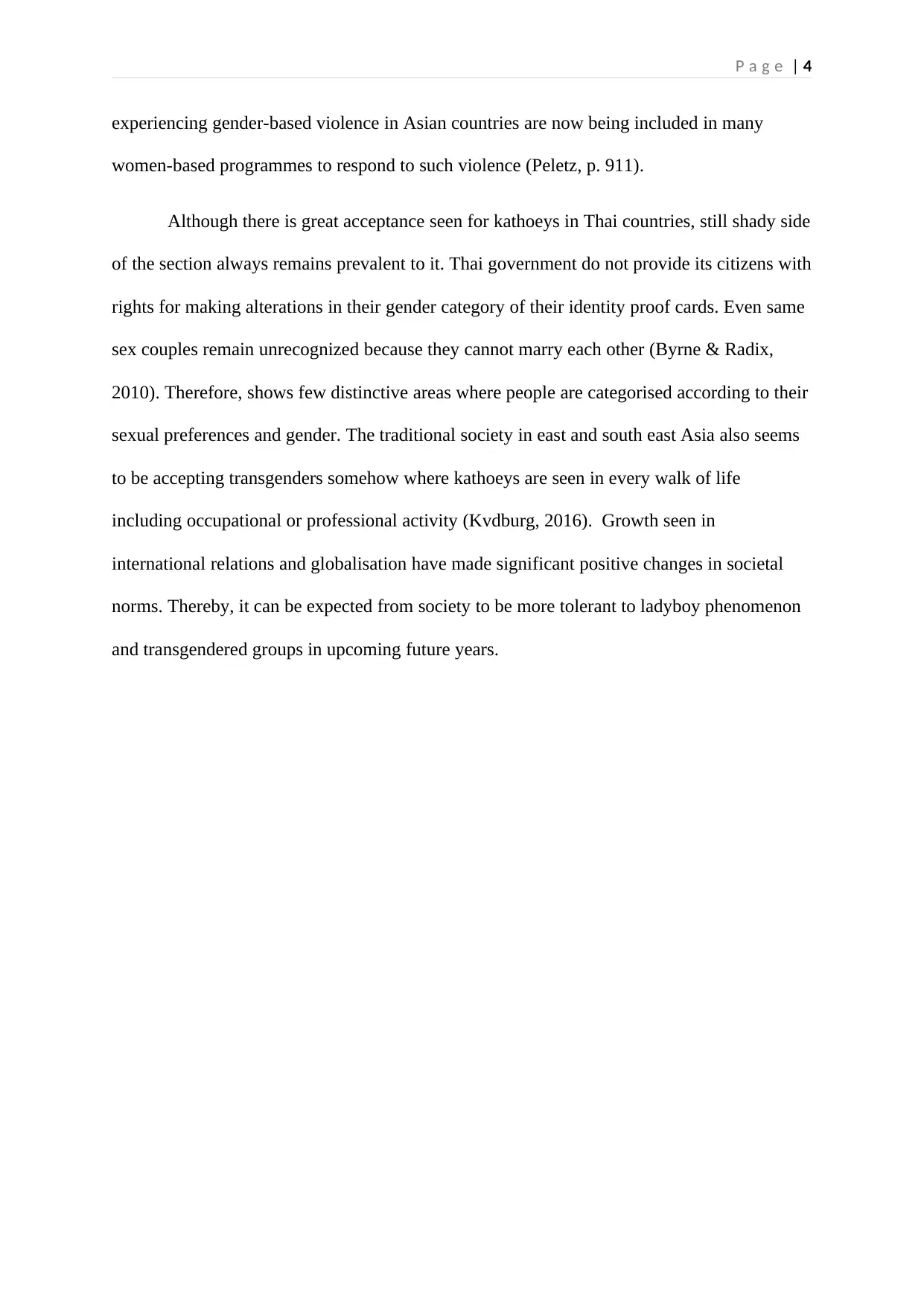
P a g e | 4
experiencing gender-based violence in Asian countries are now being included in many
women-based programmes to respond to such violence (Peletz, p. 911).
Although there is great acceptance seen for kathoeys in Thai countries, still shady side
of the section always remains prevalent to it. Thai government do not provide its citizens with
rights for making alterations in their gender category of their identity proof cards. Even same
sex couples remain unrecognized because they cannot marry each other (Byrne & Radix,
2010). Therefore, shows few distinctive areas where people are categorised according to their
sexual preferences and gender. The traditional society in east and south east Asia also seems
to be accepting transgenders somehow where kathoeys are seen in every walk of life
including occupational or professional activity (Kvdburg, 2016). Growth seen in
international relations and globalisation have made significant positive changes in societal
norms. Thereby, it can be expected from society to be more tolerant to ladyboy phenomenon
and transgendered groups in upcoming future years.
experiencing gender-based violence in Asian countries are now being included in many
women-based programmes to respond to such violence (Peletz, p. 911).
Although there is great acceptance seen for kathoeys in Thai countries, still shady side
of the section always remains prevalent to it. Thai government do not provide its citizens with
rights for making alterations in their gender category of their identity proof cards. Even same
sex couples remain unrecognized because they cannot marry each other (Byrne & Radix,
2010). Therefore, shows few distinctive areas where people are categorised according to their
sexual preferences and gender. The traditional society in east and south east Asia also seems
to be accepting transgenders somehow where kathoeys are seen in every walk of life
including occupational or professional activity (Kvdburg, 2016). Growth seen in
international relations and globalisation have made significant positive changes in societal
norms. Thereby, it can be expected from society to be more tolerant to ladyboy phenomenon
and transgendered groups in upcoming future years.
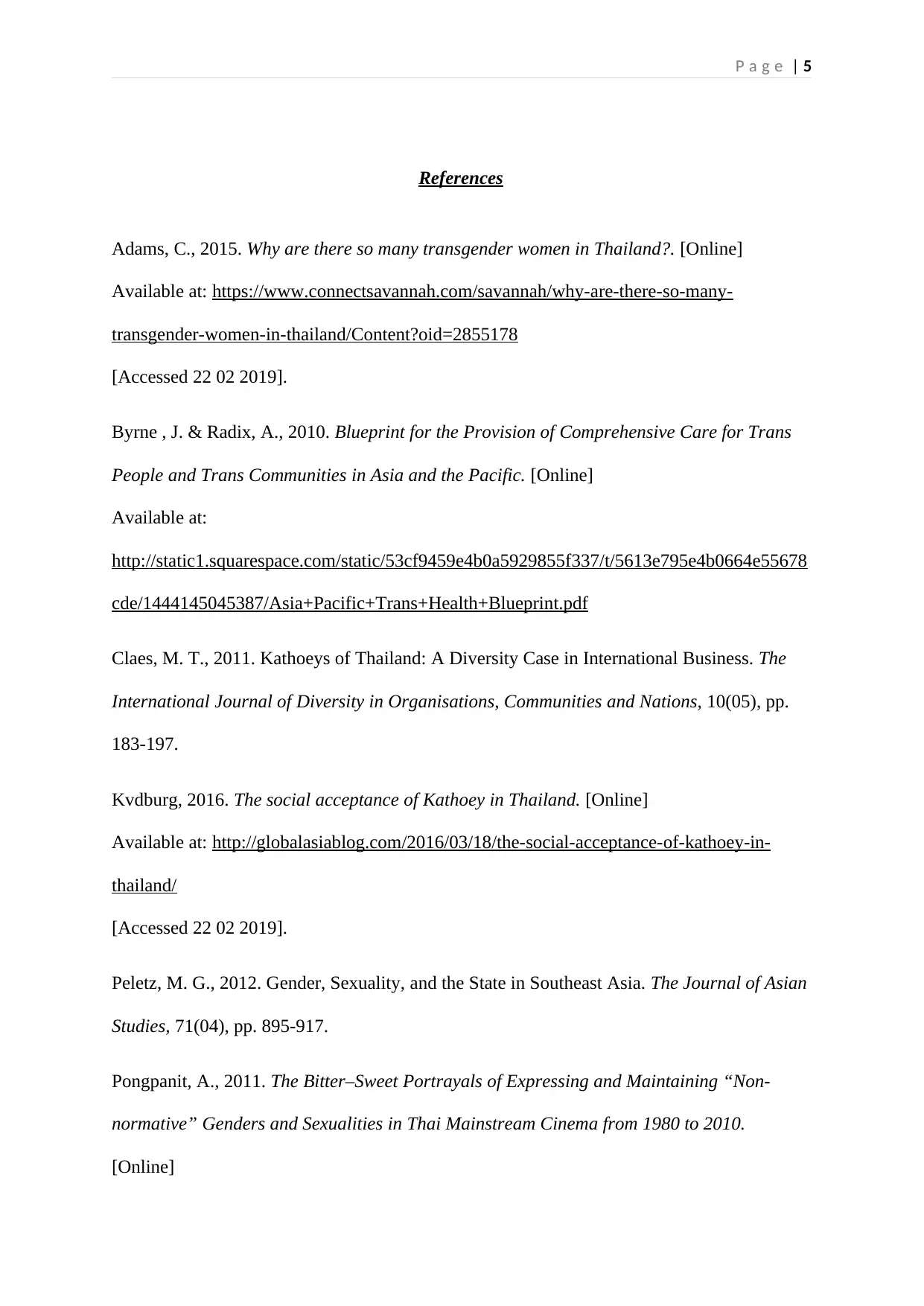
P a g e | 5
References
Adams, C., 2015. Why are there so many transgender women in Thailand?. [Online]
Available at: https://www.connectsavannah.com/savannah/why-are-there-so-many-
transgender-women-in-thailand/Content?oid=2855178
[Accessed 22 02 2019].
Byrne , J. & Radix, A., 2010. Blueprint for the Provision of Comprehensive Care for Trans
People and Trans Communities in Asia and the Pacific. [Online]
Available at:
http://static1.squarespace.com/static/53cf9459e4b0a5929855f337/t/5613e795e4b0664e55678
cde/1444145045387/Asia+Pacific+Trans+Health+Blueprint.pdf
Claes, M. T., 2011. Kathoeys of Thailand: A Diversity Case in International Business. The
International Journal of Diversity in Organisations, Communities and Nations, 10(05), pp.
183-197.
Kvdburg, 2016. The social acceptance of Kathoey in Thailand. [Online]
Available at: http://globalasiablog.com/2016/03/18/the-social-acceptance-of-kathoey-in-
thailand/
[Accessed 22 02 2019].
Peletz, M. G., 2012. Gender, Sexuality, and the State in Southeast Asia. The Journal of Asian
Studies, 71(04), pp. 895-917.
Pongpanit, A., 2011. The Bitter–Sweet Portrayals of Expressing and Maintaining “Non-
normative” Genders and Sexualities in Thai Mainstream Cinema from 1980 to 2010.
[Online]
References
Adams, C., 2015. Why are there so many transgender women in Thailand?. [Online]
Available at: https://www.connectsavannah.com/savannah/why-are-there-so-many-
transgender-women-in-thailand/Content?oid=2855178
[Accessed 22 02 2019].
Byrne , J. & Radix, A., 2010. Blueprint for the Provision of Comprehensive Care for Trans
People and Trans Communities in Asia and the Pacific. [Online]
Available at:
http://static1.squarespace.com/static/53cf9459e4b0a5929855f337/t/5613e795e4b0664e55678
cde/1444145045387/Asia+Pacific+Trans+Health+Blueprint.pdf
Claes, M. T., 2011. Kathoeys of Thailand: A Diversity Case in International Business. The
International Journal of Diversity in Organisations, Communities and Nations, 10(05), pp.
183-197.
Kvdburg, 2016. The social acceptance of Kathoey in Thailand. [Online]
Available at: http://globalasiablog.com/2016/03/18/the-social-acceptance-of-kathoey-in-
thailand/
[Accessed 22 02 2019].
Peletz, M. G., 2012. Gender, Sexuality, and the State in Southeast Asia. The Journal of Asian
Studies, 71(04), pp. 895-917.
Pongpanit, A., 2011. The Bitter–Sweet Portrayals of Expressing and Maintaining “Non-
normative” Genders and Sexualities in Thai Mainstream Cinema from 1980 to 2010.
[Online]
⊘ This is a preview!⊘
Do you want full access?
Subscribe today to unlock all pages.

Trusted by 1+ million students worldwide

P a g e | 6
Available at: https://eprints.soas.ac.uk/12763/1/Pongpanit_3283.pdf
[Accessed 22 02 2019].
Available at: https://eprints.soas.ac.uk/12763/1/Pongpanit_3283.pdf
[Accessed 22 02 2019].
1 out of 7
Your All-in-One AI-Powered Toolkit for Academic Success.
+13062052269
info@desklib.com
Available 24*7 on WhatsApp / Email
![[object Object]](/_next/static/media/star-bottom.7253800d.svg)
Unlock your academic potential
Copyright © 2020–2025 A2Z Services. All Rights Reserved. Developed and managed by ZUCOL.

